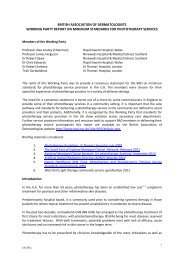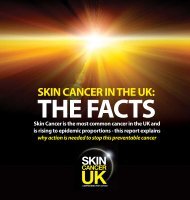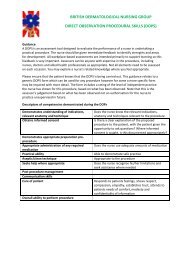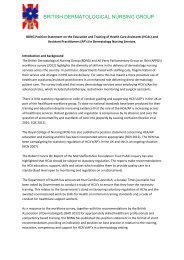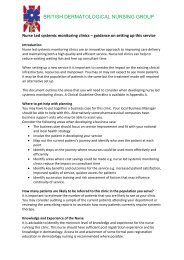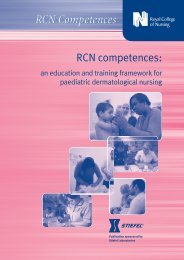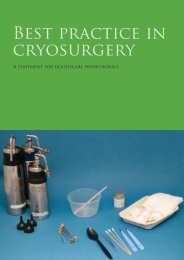Improving outcomes for people with skin tumours including melanoma
Improving outcomes for people with skin tumours including melanoma
Improving outcomes for people with skin tumours including melanoma
You also want an ePaper? Increase the reach of your titles
YUMPU automatically turns print PDFs into web optimized ePapers that Google loves.
<strong>Improving</strong> Outcomes <strong>for</strong><br />
People <strong>with</strong> Skin Tumours<br />
<strong>including</strong> Melanoma<br />
Management of special<br />
groups<br />
Observational studies that address the risk of <strong>melanoma</strong> arising from<br />
congenital melanocytic naevi (CMN) report that children <strong>with</strong> large<br />
CMN are at greatly increased risk of cutaneous and non-cutaneous<br />
<strong>melanoma</strong>, warranting continuous surveillance. Larger CMN pose a<br />
greater risk than smaller lesions. Small CMN (< 10 cm in largest<br />
diameter) are considered precursors to epidermal <strong>melanoma</strong> which<br />
largely occurs after puberty. Giant nevi (> 20 cm in largest diameter)<br />
pose a risk <strong>for</strong> dermal <strong>melanoma</strong> predominantly in pre-pubescent<br />
children, although these naevi may also produce epidermal<br />
<strong>melanoma</strong>s after puberty.<br />
Lymphoma<br />
Clinical guidelines and expert reviews support the opinion that<br />
patients <strong>with</strong> cutaneous lymphoma should be managed by an MDT.<br />
One RCT demonstrated that early intervention in mycosis fungoides<br />
using multi-agent chemotherapy does not improve survival but does<br />
increase morbidity.<br />
6<br />
Clinical guideline evidence supports avoidance of toxic or aggressive<br />
therapies in the treatment of patients <strong>with</strong> early-stage disease. Skindirected<br />
treatment (topical therapy, superficial radiotherapy and<br />
phototherapy) has been shown to achieve long periods of remission<br />
and is the most appropriate therapy in early-stage disease.<br />
Five-year survival varies according to lymphoma type and is<br />
estimated to be 70–90% in patients <strong>with</strong> mycosis fungoides and<br />
10–50% in patients <strong>with</strong> Sézary syndrome. The quality of life of<br />
patients <strong>with</strong> cutaneous lymphoma may be severely affected over<br />
many years.<br />
Kaposi’s sarcoma<br />
Two expert reviews found that HAART is associated <strong>with</strong> a dramatic<br />
decrease in the incidence of KS and can bring about tumour<br />
regression. One observational study found that HAART is associated<br />
<strong>with</strong> prolonged disease control in patients <strong>with</strong> KS.<br />
Expert review evidence reports that local therapies <strong>including</strong><br />
cryotherapy, radiotherapy and topical treatments are effective <strong>for</strong><br />
treating patients <strong>with</strong> early <strong>skin</strong> lesions and that, in general, systemic<br />
chemotherapy <strong>for</strong> KS is a treatment option <strong>for</strong> patients <strong>with</strong><br />
widespread, symptomatic disease.<br />
122<br />
National Institute <strong>for</strong> Health and Clinical Excellence




